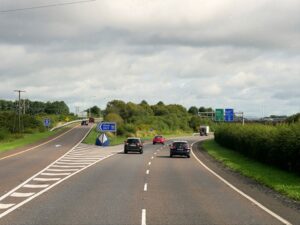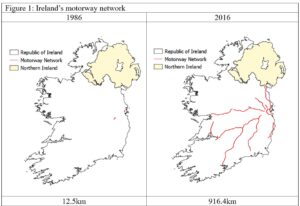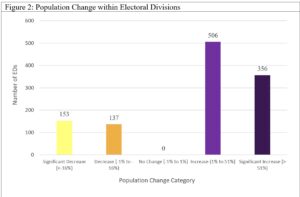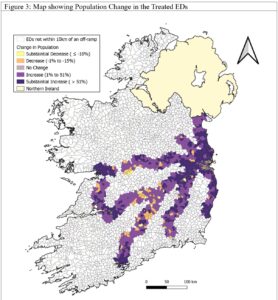This blog was written for the RSA Blog Student Summer Series that will highlight graduate student success in regional studies across the globe throughout the summer.
There has been much research on motorways and their impact on surrounding areas with considerable evidence that motorways cause suburbanisation while also increasing population levels and economic performance in rural and peripheral areas. The topic has been studied in many different countries such as America, China, Portugal, Spain, and Italy.

M20 Motorway, Exit at Junction 2 (Dooradoyle)
cc-by-sa/2.0 – © David Dixon – geograph.org.uk/p/6322743
Previously, I have examined Republic of Ireland’s (hereafter Ireland) population change across time. In this piece, I use a novel dataset of seven Censuses of Population to examine the impact of accessibility to motorway off-ramps (exits) on population change from 1986-2016 in the Ireland.

Source: Ordnance Survey Ireland, Transport Infrastructure Ireland, Ordnance Survey of Northern Ireland.
Ireland presents an interesting case study within Europe because the motorway network expanded significantly over the 30 years of our data coverage, expanding from 12.5km in 1986 to 916.4km in 2016. In some senses, Ireland lagged behind other countries who had motorways long before Ireland. While the motorway network in Ireland has greatly expanded over the 30 years, many areas in Ireland are not near the motorway, such as Kerry and the North-West of Ireland. For this blog, the population change in areas surrounding the motorway are assessed. Specifically, areas surrounding motorway off-ramps (exits) are examined, as accessibility is better measured in terms of actual access to the infrastructure rather than distance to the motorway. Based on existing international research, 10km away from the motorway off-ramp was selected as the surrounding area. This leaves us with 1,152 Electoral Divisions (EDs) within 10km of the off-ramps.
When these EDs are put into different categories based on their population change patterns, we can see the EDs within 10km of a motorway off-ramp fall into the categories described in Figure 2.

Source: (CSO and ISSDA, 1986 and 2016). Author’s own calculations.
Figure 2 shows that 74.8% (862) of the areas within 10km of a motorway off-ramp are experiencing population increases, with 30.9% (356) experiencing significant increases, and 43.9% (506) experiencing increases. Meanwhile 25.2% (290) of EDs experienced population decreases, with 13.3% (153) experiencing significant decreases, and 11.9% (137) experiencing decreases. These trends back up much of the existing research on the impact of motorways. It would be beneficial to visualise these changes to make it easier to see what areas are growing and what areas are shrinking. When examining the patterns within these EDs, we see the following.

Sources: Map: Ordnance Survey Ireland, Transport Infrastructure Ireland, Ordnance Survey of Northern Ireland. Data: CSO and ISSDA, (1986 and 2016). Map based on O’Driscoll et al. (2022).
From looking at Figure 3, a majority of the EDs which are near motorway off-ramps have experienced population increases, with many of them experiencing significant population increases. This suggests that the presence of motorway off-ramps has had a positive effect on the surrounding areas. Many of the EDs which have experienced population loss are within the urban centres, which points to suburbanisation occurring. The improved accessibility has allowed people to move to areas outside of the city centres, while still being able to commute into the centres for work, education, or amenities. It appears that motorways do have a positive effect on population growth in the surrounding areas. However, there is a need to examine the precise empirical relationship, which one of the papers in my PhD does.
While this shows that the areas near motorway off-ramps typically experience population growth, there are many other aspects that should be examined as well. While many of these areas have seen an increase in population, a map from the CSO shows that the majority of people living in many of these EDs are commuting out of these EDs to get to work. Similarly, when looking at the cardinal directions of commuters, we can see that people are commuting towards urban hubs. Thus, it appears that urban sprawl is occurring.
Additionally, there are questions about how sustainable such an approach is, both from an environmental and societal perspective. Ireland is trying to reduce its greenhouse gas emission. More roads or improved road capacity tend to lead to more cars on the road, and encourage people to drive more, either through taking more trips by car or taking longer trips, which then leads to more emissions. Research also shows that new roads or road capacity often does little to reduce traffic congestion. Thus, having a car dependent commuting pattern like Ireland is not helpful in reaching climate action goals. From a societal perspective, many of these areas face commutes than are longer than the internationally recognised 45 minute threshold for what is considered bearable. These could be potential interesting avenues for future research.
Overall, policymakers need to be aware that whilst motorways can potentially lead to population growth in areas near motorway off-ramps, they can also lead to a significant rise in car-dependent commuting within urban areas, resulting in increased CO2 emissions, and population decline in both urban and sparsely populated rural areas. Motorway investments must be complemented by additional policies aimed at improving rural economies, reducing the out-migration of younger residents, and providing opportunities for those who wish to return or relocate to such areas.

Josh O’Driscoll (Twitter: @Josh_O_Driscoll, LinkedIn) is a PhD student in the Spatial and Regional Economics Research Centre (SRERC), Department of Economics and Department of Food Business & Development in Cork University Business School, University College Cork. His research interest includes population loss, regional shrinkage, and shrinking regions.
Are you currently involved with regional research, policy, and development? The Regional Studies Association is accepting articles for their online blog. For more information, contact the Blog Editor at rsablog@regionalstudies.org.